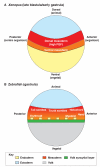FGF signalling: diverse roles during early vertebrate embryogenesis
- PMID: 20978071
- PMCID: PMC3747497
- DOI: 10.1242/dev.037689
FGF signalling: diverse roles during early vertebrate embryogenesis
Abstract
Fibroblast growth factor (FGF) signalling has been implicated during several phases of early embryogenesis, including the patterning of the embryonic axes, the induction and/or maintenance of several cell lineages and the coordination of morphogenetic movements. Here, we summarise our current understanding of the regulation and roles of FGF signalling during early vertebrate development.
Figures




Similar articles
-
Functional Roles of FGF Signaling in Early Development of Vertebrate Embryos.Cells. 2021 Aug 20;10(8):2148. doi: 10.3390/cells10082148. Cells. 2021. PMID: 34440915 Free PMC article. Review.
-
Fibroblast growth factor signaling during early vertebrate development.Endocr Rev. 2005 Feb;26(1):63-77. doi: 10.1210/er.2003-0040. Endocr Rev. 2005. PMID: 15689573 Review.
-
FGF-FGFR signaling in vertebrate organogenesis.Cell Mol Biol (Noisy-le-grand). 1999 Jul;45(5):631-8. Cell Mol Biol (Noisy-le-grand). 1999. PMID: 10512194 Review.
-
Modulation of Fgf8 activity during vertebrate brain development.Brain Res Brain Res Rev. 2005 Sep;49(2):150-7. doi: 10.1016/j.brainresrev.2004.12.035. Brain Res Brain Res Rev. 2005. PMID: 16111545 Review.
-
Involvement of Hedgehog and FGF signalling in the lamprey telencephalon: evolution of regionalization and dorsoventral patterning of the vertebrate forebrain.Development. 2011 Mar;138(6):1217-26. doi: 10.1242/dev.059360. Development. 2011. PMID: 21343370
Cited by
-
FGF primes angioblast formation by inducing ETV2 and LMO2 via FGFR1/BRAF/MEK/ERK.Cell Mol Life Sci. 2021 Mar;78(5):2199-2212. doi: 10.1007/s00018-020-03630-8. Epub 2020 Sep 10. Cell Mol Life Sci. 2021. PMID: 32910224 Free PMC article.
-
Functions of exogenous FGF signals in regulation of fibroblast to myofibroblast differentiation and extracellular matrix protein expression.Open Biol. 2022 Sep;12(9):210356. doi: 10.1098/rsob.210356. Epub 2022 Sep 14. Open Biol. 2022. PMID: 36102060 Free PMC article. Review.
-
Scaffolding proteins DLG1 and CASK cooperate to maintain the nephron progenitor population during kidney development.J Am Soc Nephrol. 2013 Jun;24(7):1127-38. doi: 10.1681/ASN.2012111074. Epub 2013 May 9. J Am Soc Nephrol. 2013. PMID: 23661808 Free PMC article.
-
Fibroblast Growth Factor Receptors (FGFRs) in Human Sperm: Expression, Functionality and Involvement in Motility Regulation.PLoS One. 2015 May 13;10(5):e0127297. doi: 10.1371/journal.pone.0127297. eCollection 2015. PLoS One. 2015. PMID: 25970615 Free PMC article.
-
FGF-independent MEK1/2 signalling in the developing foetal testis is essential for male germline differentiation in mice.BMC Biol. 2023 Dec 5;21(1):281. doi: 10.1186/s12915-023-01777-x. BMC Biol. 2023. PMID: 38053127 Free PMC article.
References
-
- Albertson RC, Yelick PC. Roles for fgf8 signaling in left-right patterning of the visceral organs and craniofacial skeleton. Dev. Biol. 2005;283:310–321. - PubMed
-
- Alvarez IS, Araujo M, Nieto MA. Neural induction in whole chick embryo cultures by FGF. Dev. Biol. 1998;199:42–54. - PubMed
-
- Amaya E, Musci TJ, Kirschner MW. Expression of a dominant negative mutant of the FGF receptor disrupts mesoderm formation in Xenopus embryos. Cell. 1991;66:257–270. - PubMed
-
- Amaya E, Stein PA, Musci TJ, Kirschner MW. FGF signalling in the early specification of mesoderm in Xenopus. Development. 1993;118:477–487. - PubMed
Publication types
MeSH terms
Substances
Grants and funding
LinkOut - more resources
Full Text Sources
Other Literature Sources
Molecular Biology Databases

